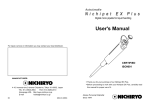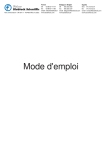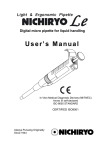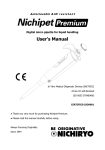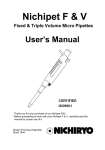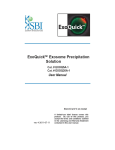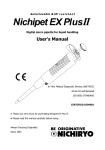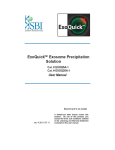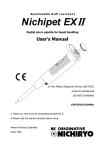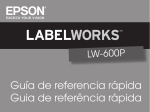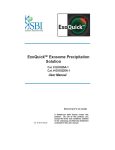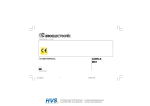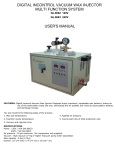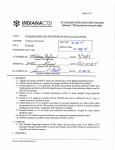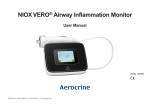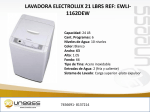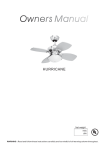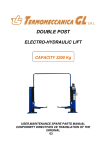Download Nichipet 7000【362KB】
Transcript
Autoclavable Nichipet 7000 Multi-channel digital micro pipette User’s manual CERTIFIED ISO9001 ●Thank you very much for purchasing Nichipet 7000. For safe and proper use of the Nichipet 7000, please be sure carefully to read this manual. After reading this manual, please keep it in a convenient place for quick reference. Always Pursuing Originality Since 1944 Autoclavable Nichipet 7000 Multi-channel digital micro pipette Features ● ● ● ● ● ● ● ● ● ● Complete autoclaving (121 °C 20 minutes) is possible with this unit. Fatigue free operation for long time. Digital system allows easy one-touch volume setting. One-touch locking function with single hand. Covering 0.5μL to 300μL range with 4 models each of 8 and 12 channels. Unit construction design helps to prevent accuracy change due to hand temperature. Suitable for sampling to a micro plate with 96 well and 9 mm pitch. Because the handle and casing angle can be adjusted freely (360 degrees), the unit can be used at a position of your choice. Includes tip eject function. The tips can be removed without touching them by fingers. The simple casing structure enables easy maintenance. Standard accessories ● Tip 8 ch ......................... x 16 12 ch ........................ x 24 ● Silicone grease ................. x 1 ● Cleaning wire ................... x 1 ● Wrench ............................ x 1 ● User’s manual .................. x 1 Please make sure that none of the above accessories are missing before using this unit. Safety precautions ● For safe and proper use of the Nichipet 7000, please be sure carefully to read the“Safety precautions” in this section and “CAUTIONS” on the next page before starting work with it. ● The contents of “CAUTIONS” are matters that require the user’s attention, not only for using the Nichipet 7000 properly, but also for preventing the user from accidents and physical damage. ● After reading this manual, please keep it in a convenient place for quick reference. - 1- Please observe the following cautions to ensure the safe use of this product CAUTIONS Be sure to observe the following instructions for using Nichipet 7000 properly and safely. If the user misuses the Nichipet 7000, or disregards the following instructions, it may result in injury to the user or/and other persons or physical damage to this instrument or/and other equipment. 1. Do not use for any other purpose than handling of liquid. 2. Never modify this instrument, as this may cause an accident. 3. Do not use for handling of liquids that will be directly injected into the body. 4. As certain types of liquids are harmful to the body, never discharge any sample liquid while pointing the instrument at a person 5. Do not eject tips while this unit is pointed at a person. 6. Do not eject tips when there is liquid inside. 7. The sharp protruding tips of the unit are dangerous. Please use care when handling. 8. Please make sure that the tips are securely attached to the nozzle. Scattering of liquid will occur if tips fall off the nozzle. 9. If liquid that is harmful to the body has splashed onto the unit, treat it properly before using it. 10. When using liquid that is harmful to the body, never touch a tip that has been used. 11. Do not use this unit to mix liquid etc. This will cause tips to loosen, fall off, or result in liquid splashing on the unit. 12. After autoclaving or drying, do not touch the unit as it is very hot. Touching the unit could result in bodily harm. 13. Although this product is designed to resist chemicals, it may be damaged by some kinds of chemicals such as N-methyl-pyrrolidinone, etc. Please contact the manufacturer before using special chemicals. CAUTIONS to dispose pipettes or tips Please follow local low or ordinance when pipettes or tips are disposed. - 2- NOTE Users are required to strictly observe the following points in order for the instrument to keep its excellent precision, reproducibility and original performance for a long time. 1. Do not expose pipette directly to the sun when working with it or for 2 hours before starting work, otherwise the pipette may lose accuracy. Avoid working with pipettes in a humid and hot place. 2. Just before starting work with pipette, avoid touching tip and nozzle cylinder as far as conditions are allowed. If nozzle cylinder is warmed by your hand, accuracy may vary. 3. For pipetting, follow the forward method (the way explained in this manual). If it is performed in a different way, it may result in inaccurate pipetting. 4. Operate push button very gently. If it is quickly released, it may result not only inaccurate pipetting but also deteriorated the pipette because sample liquid may be permeated into the main body. 5. Do not reuse tip that has been used once, and carefully dispose used tip. If tip is used repeatedly, it may cause inaccurate and impure pipetting and cross contamination (*) among samples. *. For example, if previous sample liquid is left inside tip, it is mixed with new sample liquid and the new sample is contaminated by the previous one. Therefore, pipetting of the next sample results wrong. This phenomenon is called mutual contamination of samples. 6. Do not hold pipette horizontally or upside down when there is liquid inside tip, otherwise the liquid gets into the main body and the pipette may be contaminated. 7. When autoclaving, do not pile pipettes on others in the autoclave or lean pipettes with a nozzle top facing down so that self-load is applied on the nozzle. This pipette is made of an autoclave compatible material, but because of high temperature in the sterilizer, there is a risk that parts subject to load will be deformed. 8. After autoclaving and drying pipette, leave it until it gets completely cool before using again. If the pipette is used when warm, the accuracy may not come up to the standard level. 9. After autoclaving and drying pipette, assemble the pipette after it is completely cooled, if it is assembled when it is still hot, it may cause deterioration in the pipette such as breakage of the screw threads. 10. When rotating push button, do not exceed the specified sample volume limit, otherwise pipette may be damaged or deteriorated. 11. Do not perform pipetting with less liquid than set volume. If the quantity of liquid is less than the set volume, it may cause the liquid to scatter into the main body and the pipette may deteriorate in quality. - 3- Contents Operating procedure ······················································· 5 Disassembling/Reassembling the airtight chamber ··················· 9 Autoclaving/Drying the pipette ··········································· 17 Specification ································································· 18 Calibration procedure······················································· 19 Troubleshooting ····························································· 21 Parts list······································································· 23 - 4- Operation 1. Volume setting 1) Turn the lock handle to the unlock direction and loosen it. (Fig. A) 2) Turn the push button to set the digital counter to the desired volume. When increasing volume, first set the scale a half revolution further, and then set it to the desired amount. When decreasing the volume, the scale can be set directly to the desired amount. At this time set the counter’s scale to the pointer mark located at the bottom section of the counter window. (Fig. B) 3) After volume setting, turn the lock handle in the lock direction and tighten. (Fig. A). Note: Do not exceed the specified liquid volume limit, otherwise the instrument may be damaged or deteriorate in the quality. Note: After changing the volume, use the unit after first carrying out a trial operation. Lock Push button V(10μL) Unlock l 0μ 20 ol u m e 1 0 40 ~ V L(200μL) Lock handle 2 0 0 Pointer mark Fig. A Fig. B 2. Suction 1) Attach the disposable tip to the nozzle (attach from the rack when doing so). 2) Press the push button down to a ~ b. (Fig. C) 3) With the push button pressed down, insert the top of the tip to a point suitable for suction of the desired volume. (Fig. D-1). 4) Return the push button gently to its original position. The liquid will be pulled into the tip. At this time pause for 1 second to wait for complete suction of the liquid. (Fig. D-2). 5) Withdraw the tip gently from the liquid. By doing this gently, hardly any of the liquid will remain on the outside surface of the tip. If liquid does remain, remove it by paper or something similar, being careful not to touch the tip’s point. - 5- Note: Do not carry out suction from the c position shown in Fig. C. (liquid will be pulled into the nozzle if done from this position) Note: Operate the push button gently. Releasing quickly will cause liquid to be pulled into the inside of the unit causing possible loss of accuracy. a b c Fig. C 1 2 3 4 5 6 Fig. D 3. Discharge 1) Touch the top of the tip to the inside of the receiving vessel. (Fig. D-3). 2) Gently depress the push button from a to b. Wait about 1 second, then depress to the c position. The liquid is now discharged. (Fig. D-4,5). 3) Press the eject button to remove the used tip. (Fig. D-6). Do not touch the tip during use or after use when liquid that is harmful to the body is being used. - 6- Disassembly and assembly of the airtight unit If any of the problems included in the “Troubleshooting” section of this manual arise, use the following procedure to disassemble and inspect this unit. 1. Disassembly 1) Turn the ring in the direction of the arrow and remove the casing from the handle. (Fig. 1) Note: If the connection screw is loosened, tighten it with the provided wrench. (Fig. 2) 2) Remove the screw that holds the ejector and remove the ejector from the casing. (Fig. 3) 3) Remove the screw that holds the casing. (Fig. 4) 4) Lightly press the nozzle and remove the casing A set as shown in Fig. 4. 5) Remove each part. (Fig. 5) 2. Assembly 1) Attach each part to casing B. (Fig. 5) 2) Assemble and attach the casing A set. (Fig. 4) 3) Assemble and attach the ejector to the assembled casing. (Fig. 3) 4) Assemble and attach the casing set to the handle. (Fig. 1) Note: When assembling be sure to set the counter to the maximum volume range. (Parts will not mesh properly) Note: If the connection screw is loosened, tighten it with the provided wrench. (Fig. 2) Handle Handle Ring Ring Casing Wrench Connection washer Fig. 1 Connection screw Fig. 2 - 7- Ejector set Ejector plate Fig. 3 Ejector plate holding screw Casing Aset Ejector button Casing holding screw Fig. 4 - 8- Fig. 5 - 9- Position to gear plungears Nozzle spring holder Nozzle spring Nozzle X ring Plunger set Casing B X ring holder Plunger holder set First spring Bush Plunger head spring Autoclaving Autoclaving of this complete unit is possible. Follow the procedure below at a temperature of 121° C for 20 minutes. 1) Be sure to loosen the lock handle and set the counter to the maximum volume number of the volume range.(Fig.A) 2) Loosen a connecting screw in the Fig.2 by 180 degree. 3) Loosen four screws on the casing in the Fig.4 by 180 degree. 4) When placing inside the autoclaving unit, be careful not to damage the nozzle. Also, place in a position that does not put any weight on the nozzle. 5) After autoclaving, be sure to dry the unit thoroughly. Drying Carry out drying immediately after autoclaving. Dry the unit thoroughly in a constant temperature air-drier at 60° C for over 60 minutes. 1) Dry the product in the same condition as when it was autoclaved. 2) Be careful not to damage the nozzle when placing the unit in the dryer. Also make sure that the unit is placed in a position that does not place any weight on the nozzle. 3) Make sure that the unit turned to the normal temperature after the drying. Tighten the connecting screw in the Fig.2 and four screws on the casing in the Fig.4. And make sure that a ring in the Fig.1 is tightened. Note: After drying, if the unit is assembled while it is still warm, screw head damage etc., may occur causing damage to the product or loss of product performance. Be sure to reassemble the unit after it has completely cooled down. Also, using the product while it is warm may result in loss of accuracy. Do not touch the unit directly with your hand just after autoclaving and drying, because the unit is extremely hot during autoclaving and drying. Directly touching the hot unit may cause an accident. - 10- ●Maximum Permissible Errors Pipette types (Code) Volume range NP7-8V NP7-12V (0.5~10uL) 0.5-10 (uL) Accuracy (%) Precision (%) ±8.0 ≤4.0 ±4.0 ≤2.0 5 NP7-8S NP7-12S (5~50uL) 5-50 (uL) NP7-8L NP7-12L (40~200uL) 40-200 (uL) NP7-8K NP7-12K (50~300uL) Measured volume (uL) 1 50-300 (uL) 10 ±2.0 ≤1.0 5 ±3.0 ≤1.5 25 ±2.0 ≤0.8 50 ±1.0 ≤0.5 40 ±1.4 ≤0.5 100 ±1.0 ≤0.4 200 ±0.9 ≤0.3 50 ±1.4 ≤0.7 150 ±1.0 ≤0.5 300 ±0.6 ≤0.2 ●Tips (autoclavable) Tip length (mm) 31.5 1000 NP7-8S,12S、8L,12L 53.0 1000 NP7-8K,12K 58.9 1000 BMT2-UT Volume range (uL) 0.1-10 Natural NP7-8V,12V BMT2-SG 5-200 Natural BMT2-K 50-300 Natural Code Color Applicable model Q’ty ●Rack tips (autoclavable) BMT2-UTR Volume range (uL) 0.1-10 Natural NP7-8V,12V 960(96 x 10cases) BMT2-SGR 5-200 Natural NP7-8S,12S、8L,12L 960(96 x 10cases) BMT2-KR 50-300 Natural NP7-8K,12K 960(96 x 10cases) Code Color Applicable model - 11- Q’ty RECALIBRATION PROCEDURE 1. Remove the cap by pulling it out with your fingers. (Fig.6) 2. Loosen the lock handle by turning it counter clockwise and stop when the oval opening on the lock handle faces you. (Fig.7) 3. Rotate the push button until one of two hex head screws can be seen through the oval opening. (Fig.7) 4. Loosen both hex head screws with a hex head wrench (1.5 mm) by turning them counterclockwise one by one. (Fig.8) 5. Keeping the hex head wrench inserted into one hex head serew, turn the push button to calibrate the pipette. (Fig.8) 6. The pipetting volume can be adjusted by rotating the push button clockwise to increase and counter-clockwise to decrease. Please refer to the table standard volume adjustments. Angle 360゜ 720゜ 0.5-10uL 0.31uL 0.63uL 5-50uL 1.6uL 3.2uL 40-200uL 6.5uL 13uL 50-300uL 9.6uL 19.2uL 7. Tighten the both hex head screws after adjusting the push button and measure the accuracy of the pipette. 8. Repeat the above procedures until the pipette is calibrated within the specified accuracy. An accuracy test should be made at the specified minimum and maximum volume of each pipette. 9. Return the cap to its original position. Cap Fig.6 Push button A : Increase B : Decrease Lock handle Oval opening Hex head scre w Hex head wrench Fig.7 Fig.8 - 12- Troubleshooting Problem Liquid is not sucked in. Liquid leakage from tip. Push button movement is poor. Looseness of body and casing. Probable cause Solution Foreign matter in the nozzle. Remove foreign matter with provided cleaning wire. X ring is worn or damaged. Replace the “X ring set” with the new set. Plunger is damaged or rusty. Replace the “X ring set” and “Plunger set” with the new sets. Nozzle tip attachment part is damaged. Replace the “nozzle set ” with the new set. Attached tips are loose. Attach the tips firmly. Plunger has shifted. Press the push button a few times. X ring is damaged. Replace the “X ring set” with the new set. No grease on the plungers and/or X rings. Coat the plungers and/or X rings lightly with the provided grease. Liquid in the nozzle. If immediately after suction or if there just some adherence of liquid, disassemble and clean the parts. Ring is loose. Tighten the ring Connection screw is loose. Tighten the connection screw with the provided wrench. If the problem persists even after the above points have been checked, stop usage of the unit immediately and consult with the sales outlet where the unit was purchased. Caution: At this time please confirm that there has been no contamination by chemicals that are harmful to the human body. - 13- ●Replacement parts list (Please specify volume and channel number when ordering) Spare parts Ring Connection washer Connection screw Casing A set Casing B Plunger fixing unit set Plunger head spring set Plunger set X ring suppressor set Nozzle spring holder set X ring set Nozzle set Nozzle spring set Casing holding screw Ejector set Wrench Contents x1 x1 x1 Casing A (x 1) Insert nut (x 5) Ejector button (x 1) Ejector shaft A (x 1) Ejector shaft B (x 1) Ejector spring (x 1) x1 Plunger fixing unit (x 1) First spring (x 2) Guide shaft (x 2) Guide tube (x 2) E ring (x 4) Bush (x 1) Stem (x 1) 8ch x 8, 12ch x 12 Plunger (8ch x 8, 12ch x 12) Plunger head (8ch x 8, 12ch x 12) X ring suppressor (8ch x 2, 12ch x 3) Nozzle spring holder (8ch x 2, 12ch x 3) X ring (8ch x 8, 12ch x 12) Nozzle (8ch x 8, 12ch x 12) Nozzle spring (8ch x 8, 12ch x 12) x4 Ejector plate (x 1) Ejector plate holding screw (x 1) x1 Size Common Common Common Each size Each size Each size Common Each size Each size Common Each size Each size Common Common Each size Common Note: Parts marked with a star (☆) influence precision of the product. When replacing these parts, please replace all of them with new parts. ※ Please contact your local distributor for price information. ※ Specifications of the instruments and optional accessories as well as contents of accessory sets are subject to change without notice. ※ No part of this manual may be reproduced/reprinted in any form without permission of the copyright holder. (This is strictly prohibited by the copyright law.) - 14- Inspection and Calibration Statement The enclosed pipette was tested and calibrated under closely controlled environmental conditions to ensure that it meets published calibration specifications. The precision and accuracy results obtained for this pipette are provided on the enclosed calibration certificate. Because temperature and humidity conditions affect the calibration results of liquid measurement devices, your pipette should be calibrated under conditions of use. The calibration results obtained in your laboratory may vary from our results due to differences in environmental testing conditions. Tokyo office 1-10-1 Kandanishiki-cho, Chiyoda-ku, Tokyo 101-0054, Japan TEL: +81-3-6273-7652(English) FAX: +81-3-6273-7944 URL: http://www.nichiryo.co.jp/ E-mail: [email protected] 2013.Ver.1
















